Edward Armstrong Sr.
https://sites.rootsweb.com/~onleedsg/research-census.html
Edward
Armstrong Sr. was born about 1750, in Unknown, and died 1795, in Elizabethtown Twp.,
Leeds Co., Upper Canada, at about age 45.
He is
the son of
Unknown Armstrong, and
Unknown Unknown.
Catherine "Caty" Adams??? was born
about 1750, in Unknown, and died after 1803, in Unknown.
Buried in Lewis Cemetery,
Granby, Oswego Co., NY. She
is the daughter
of Unknown.
Edward
Armstrong
Sr. and Catherine
"Caty" Adams??? were married
about 1765, in Unknown.
Edward
Armstrong
Sr. and Catherine
"Caty" Adams??? Armstrong had
at least 5 children:
-
John H. Armstrong: Born about 1771 in British
America;
Died April 24, 1848, probably
in the Front End of Yonge Twp., Leeds Co., District of Johnstown, Canada
West (about age 77).
Buried in Lewis Cemetery, Lewis Corners, Granby Twp., Oswego Co., NY.
Married by banns, January 2, 1815, in
Elizabethtown-Kitley Twp., Leeds Co.,
Province of Upper Canada,
to
Mary B. "Polly" Wood: Born 1800 in Leeds,
Leeds Co., Province of Upper Canada; Died 1878 in
Oswego, Oswego Co., NY (about age 78).
Buried in Lewis Cemetery, Lewis Corners, Granby Twp., Oswego Co., NY.
- Edward
Armstrong Jr.: Born before 1773, in British America; Died Unknown, in
Grantham, Niagara Co., Ontario, Canada. Possibly Married about 1802, in
Augusta Twp., Leeds Co., Province of Upper Canada, to Phoebe Mallory: Born
Unknown; Died Unknown.
- Margaret
Armstrong: Born
1777 or 1778, in British North America; Died March 30, 1855, in the
Village of Ingersoll, Oxford Co.,
Upper Canada (about age 75). Buried in Kirkwall
Presbyterian Cemetery, Flamborough, Wentworth Co., Ontario, Canada.
Married (1) about 1794, in Leeds Co., Province of Quebec, to
Theodorus
Allen: Born
September, 1763, in Massachusetts; Died 1800, in Augusta Twp., Leeds Co.,
Province of Upper Canada (about age 37). Married (2)
Unknown,
in Elizabethtown Twp.,
Leeds Co., Province of
Upper Canada, to John Fletcher: Born 1774, in New Hampshire,
British America;
Died November 1, 1849, in
the Village of Ingersoll, Oxford Co., Upper Canada
(about age 75).
- Daughter
Armstrong: Born before
September 24, 1784,
in Augusta Twp., Leeds Co., Province of Quebec;
Died before
September 24, 1784,
in Augusta Twp., Leeds Co., Province of Quebec (age
Infant).
- Adolphus
Armstrong: Born about 1789, in
Province of Quebec;
Died September 25, 1828,
in
Eramosa, Wellington Co.,
Province of
Upper Canada (about age 39). Married March 2, 1811, in Augusta Twp.,
Leeds Co., Province of
Upper Canada, to Charity Dopp: Born 1789, in
Augusta Twp., Leeds Co., Province of Quebec; Died 1832, in
Goodwood, Uxbridge Co.,
Province of Upper Canada
(about age 43).
- James
Armstrong: Born
about 1790, in
Elizabethtown Twp., Leeds Co.,
Province of Upper Canada; Died
1867, in Grantham, Niagara Co., Ontario, Canada, at about age 77. Married
March 1, 1822,
in Unknown, to
Catherine Hainer: Born 1799, in the
Province of Upper Canada; Died Unknown.
TIMELINE
Ontario was known as: "Upper Canada" from
December
26, 1791, to February 10, 1841;
"Canada West" from February 10, 1841, to July
1, 1867; and
"Ontario" after July 1, 1867.
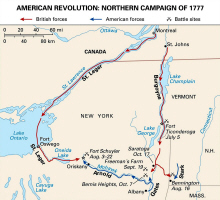
General Burgoyne campaign map, 1777.
From
freepages.rootsweb.com: Armstrong, Edward Sr..... of Elizabethtown, He is Dead,
Suffered imprisonment in Albany gaol from 1777 to 1783, O.I.C. May 12, 1808.
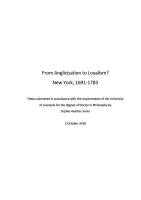

Loyalist Thesis by Sophie Heather Jones, 2018.
A map by Claude Joseph Sauthier and Matthäus Albrecht Lotter, of the
Provinces of New-York and New Yersey, with a part of Pennsylvania and Canada or
the Province of Quebec. Augsburg, 1777. Library of Congress, Geography and Map
Division.
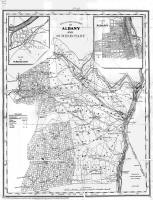
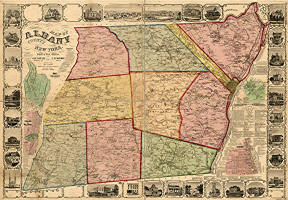
Historic map of Albany and Schenectady Counties, NY. Maps courtesy of Kay Koslan.
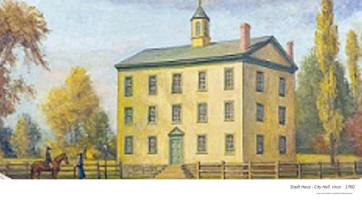
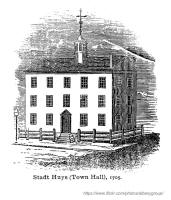
The Old
Albany Jail, or in Dutch, "Stadt Haus."
During the Revolutionary era, the city hall housed the Albany Committee of
Correspondence - an extra-legal body that served as the civilian arm of the
crusade for American liberties and also governed the city between 1775 and 1778.
For a time, prisoners of war and Tories joined common criminals in the basement
of the Albany jail. Beginning in 1780 - and intermittently until 1797, the New
York State government also held sessions in the Court Street.
https://exhibitions.nysm.nysed.gov/albany/loc/cityhall.html#sh
In 1741 the city fathers thought it was time for new digs and a new building
was constructed on the same location, surrounded by greenery and trees. It was
much larger 3 story building of brick, but simple and plain. It had a steep roof
and a belfry. It too had a jail. It was on the steps of this building that the
Declaration of Independence was first read to the city in July, 1776 and where
Ben Franklin first proposed the Albany Plan of Union – a confederation of the
British colonies in 1754, 20 years before the Continental Congress was formed.
Edward
Armstrong Sr. was born
before 1773 in British America.
Catherine "Caty" Adams???
was born about 1750, in Unknown.
Edward
Armstrong
Sr. and Catherine
"Caty" Adams??? were married
about 1765, in Unknown.
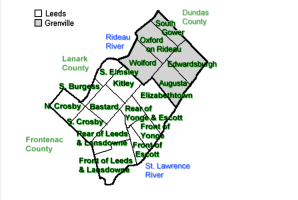
Historic map of Albany and Schenectady Counties, NY. Map courtesy of Kay
Koslan.
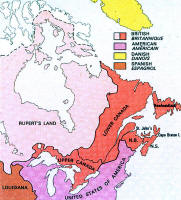
The Canadian Provinces established in 1791.
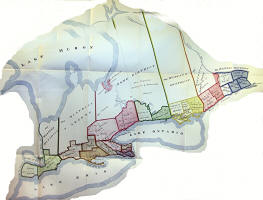
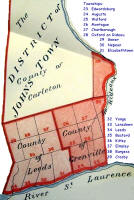
All Districts, and the Johnstown District, Upper Canada, 1800.
Edward
Armstrong of Elizabeth Twp., Leeds Co., Upper Canada, was an
U. E. Loyalist, and was imprisoned by the Rebels (the Colonial Army) in Albany, in 1777, on account
of his loyalty to the Crown, and remained a prisoner there until the Treaty of Separation in
1783, when he was liberated. Edward Armstrong came to Canada in 1784, and chose
his residence in Elizabethtown Twp., Leeds Co., Upper Canada. He died in
Elizabethtown Twp., Leeds Co., Upper Canada, in 1795, which was before the
formation of the U. E. List. On June 26, 1807, at York, Ontario, Upper Canada,
Edward Armstrong Jr., requested that his father, Edward Armstrong, be placed on
the List of U. E. Loyalists.
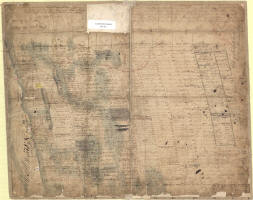

Older Handwritten Land Grant Map.
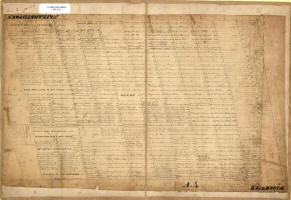
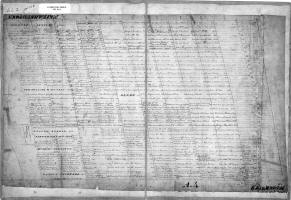
Newer Lettered Land Grant Map.
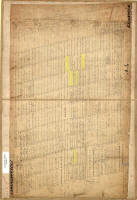
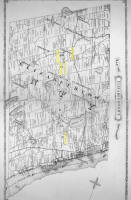
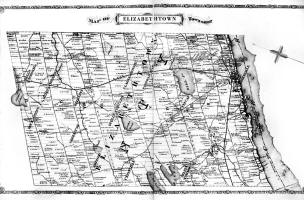
PDF images with Edward Armstrong and
Allen original land holdings, and ca. 1860 map overlay with original lands
highlighted highlighted.
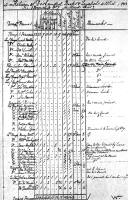
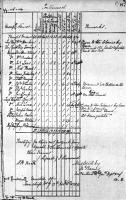
From
Haldimand Abstract Books.
Edward Armstrong Sr. is a refugee loyalist date of
certificate is August 28, 1784. And the paperwork or when those were mustered
out on October 12, 1784, by Colonel Edward Jessup's Corps were to be the first
settlers of the new Royal Township (from the bottom of page 87). It lists at
the top of page 86 that they are going to Township 7. There are 2 males
above age 10 and 2 females under age 10, which means the males could be born
on/before 1773 and the females would be born on/after 1773. The one female
could be Margaret. The boys should be John H. Armstrong, and Edward, Jr. The
girls should be Margaret Armstrong, and Unknown Female.
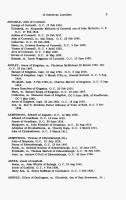
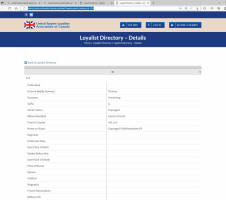
All of the children of Edward
Armstrong Sr., and most of the children of Thomas Armstrong, Sr., U. E.
Loyalists, were eligible to receive a land grant based upon their fathers'
loyalty to the King of England. Thomas Armstrong Jr. was Expunged from the
U. E. Loyalist List in 1804 - 1805.
Edward
Armstrong Sr. died 1795, in Elizabethtown Twp.,
Leeds Co., Upper Canada, at age Unknown.
In 1803, Catherine "Caty" (Unknown)
Armstrong
certified
that in 1795 she, along with her eldest son, John H. Armstrong of the late Edward
Armstrong, had signed the transfer of Lot 17 Con 2 Elizabethtown, to James
McDonald (1st Heir & Devisee Commission v.6 Eastern Dist Location Certificates,
p.74).
In the 1803 Elizabethtown Census, Caty
Armstrong is living alone, while her young sons, Adolphus Armstrong and and James
Armstrong, are living with
their sister, Margaret and her family with John Fletcher.
The British Constitutional Act of 1791
officially divided the old colony of "Province of Quebec" into the primarily
French-speaking "Province of Lower Canada," and the primarily English-speaking
"Province of Upper Canada." Upper Canada was located upriver, closest to the
source of the St. Lawrence river.
In 1841, the Act of Union officially united the two Provinces
into the single Province of Canada, with the creation of Canada East, Province
of Canada, and Canada
West, Province of Canada.
Ontario was known as: "Province
of Upper Canada" from
December
26, 1791, to February 10, 1841;
"Canada West" from February 10, 1841, to July
1, 1867; and
"Ontario" after July 1, 1867.
Canada was founded on July 1, 1867. On this
date, the colonies of Canada, New Brunswick, and Nova Scotia linked to form the
sovereign dominion of Canada in a process called confederation. At this time,
Upper Canada and Lower Canada became Quebec and Ontario. Therefore the new
confederation comprised of four provinces: Nova Scotia, New Brunswick, Quebec,
and Ontario. The confederation led to a territorial evolution leading to the
incorporation of other parts of British North America into the newly formed
entity of Canada to form what is today contemporary Canada. Newfoundland and
Labrador was the last province to be incorporated into the confederation in
1949. For a period of many years since Confederation, Canada has undergone many
territorial changes and expansions, eventually forming the current union of ten
provinces and three territories.
The formation of Canada and attainment of its
independence was a gradual process. Despite the existence of a responsible
government in Canada, the United Kingdom continued to claim sovereignty over the
land until the end of the World War I. The 1931 passing of the statute of
Westminster recognized Canada as equal with the United Kingdom but the country
was denied the power to amend its constitution. Dependence on the British
parliament in Canada was removed in 1982 after patriation of the constitution.
Canada is a federal parliamentary democracy and a constitutional monarchy, with
Queen Elizabeth II being the head of state.
Who were the Loyalists? The most common depictions are of
wealthy aristocrats, more concerned with making money than the plight of the
poor, working-class families living under tyranny. But what if I told you
that in Albany, New York, the home of Philip Schuyler, it was almost the
exact opposite situation? Here most Loyalists were poor families called
“tenant farmers”. They farmed land for wealthy families like the Schuylers
and their relatives, keeping a portion of what they grew for themselves and
giving a portion to their landlords, along with money for rent. They also
had to perform other labor for their landlords, like the backbreaking work
of clearing new fields, caring for livestock, and transporting goods to be
sold. Sometimes the arrangement was a relatively fair one, but other times
these tenants felt that the Schuylers and the other landlords used their
power and money to squeeze too much from their tenants.
In the 1766, before the Revolutionary War, many of these
tenants rose up against their landlords in what is known as Prendergast’s
Rebellion, after one of its main leaders, William Prendergast. It is hard
today to understand just how important control of land was in the 18th century.
People lived and died by the land. If you controlled the land, you
controlled the money, the livelihoods of others, the local government,
everything. The tenant farmers felt that their concerns weren’t being
listened to in the local government, which was also made up of their
landlords, and so, in line with the Revolutionary spirit around them, they
took up arms to defend their rights. They refused taxation without adequate
representation, and demanded that abuses of power by those who both
controlled the land and the government be stopped. The land-holding families
quickly organized their own supporters to confront them, capturing
Prendergast and putting him on trial. William Prendergast was sentenced to
death by a jury that included members of the Sons of Liberty. It didn’t
matter that he had stood up for his rights- he had stood up against the
wrong people. Before he could be executed though, the British Crown
interceded on his behalf. Rather than risk an all-out rebellion by the
tenant farmers, the Crown pardoned Prendergast. This helped to calm the
tenant farmers, but it enraged the landholders. Years later, Thomas
Jefferson would accuse the King of “[exciting] domestic insurrections
amongst us…”. Us. The landlords.
These landlords had been expressing more and more discontent
with the Royal British government since the end of the French and Indian
War. British regulation of commerce cut into their business. They wanted a
large say in the government. The Proclamation Line meant that they couldn’t
claim Native American lands to the west in order to increase their holdings.
In short, they felt that the Crown controlled the land, the money, and the
government. Sound familiar? Of course, their complaints were legitimate,
while the concerns of the tenant farmers were to be put down with force.
By the time that the Revolutionary War broke out in 1775, the
landlords considered the British Crown to be their biggest threat to
liberty. To many tenant farming families, the Crown represented a check
against the power of the Landlords. The Revolutionaries, led by the
land-holding aristocracy, needed to keep tight control over those tenant
farmers who sided with the Crown. Many of them were arrested for refusing to
join the Revolution. Some were executed, others imprisoned. Eventually the
prison was so crowded with Loyalists that the Albany Committee to Detect and
Defeat Conspiracies decided to use the old fort as a prison camp for anyone
who dared to speak out against them. A sense of hysteria swept over Albany,
similar to the “Red Scare” that gripped America in the 1950’s. Even people
without any Loyalist connections could be arrested. Almost every day people
were told that they had to pay £100 to be released, even after being found
innocent. This could be as much as two years of income for some families. It
became very dangerous to be known as a Loyalist in Albany.
So why does this history matter? And why do I talk about it
at the Schuyler’s home? After all, the Schuylers were Revolutionaries, not
Loyalists. There are two answers to this question. The first, and simplest,
is that to understand who Philip Schuyler was and why he joined the
Revolution, we should have a clear understanding of who the “other side”
really was, beyond the myths about Loyalists as wealthy merchants appalled
at the idea of Democracy.
New
York Land and Property at Family Search
New York Church Records
at Family Search
Leeds County was established in 1792, one of
the original nineteen counties created by Governor John Graves Simcoe. It was
named for the fifth Duke of Leeds, Francis Godolphin Osborne.The area was first settled by United
Empire Loyalists who arrived in 1784. Townships were set aside for specific
soldiers, for instance Township 8 (Elizabethtown Township) was set aside for
Jessup's Loyal Rangers.
In 1788 western Leeds County was opened
for settlement, in the 1790's the rear townships were opened. Settlement was
slow until after the war of 1812 when disbanded soldiers and British emigrants
settled in the area. A majority of the British emigrants were from Scotland and
arrived in 1816. Even more settlement occurred during the 1820's after the
construction of the Rideau Canal.
1792 - 1798 - part of Eastern District.
1798 - 1849 - part of Leeds District.
1850 - present - Part of the municipality
of the United Counties of Leeds and Grenville.
Grenville County was established as a
county in Eastern District in 1792. It was named for British Secretary-of-State
for Foreign Affairs, William Wyndham Grenville.
As with Leeds County, Grenville
County's first settlers were United Empire Loyalists (specifically Jessup's
Loyal Rangers) who arrived in 1784 and settled along the St. Lawrence River.
Grenville County is primarily rural but
is also the home of several successful industries including the Canada Starch
Company, the first starch factory in Canada (established 1858).
Edward
Armstrong of Elizabethtown Twp., Leeds Co., Upper Canada, was an
U. E. Loyalist, and was imprisoned by the Rebels in Albany, in 1777, on account
of his loyalty, and remained a prisoner there until the Treaty of Separation in
1783, when he was liberated. Edward Armstrong came to Canada in 1784, and chose
his residence in Elizabethtown Twp., Leeds Co., Upper Canada. He died in
Elizabethtown Twp., Leeds Co., Upper Canada, in 1795, which was before the
formation of the U. E. List. On June 26, 1807, at York, Ontario, Upper Canada,
Edward Armstrong Jr., requested that his father, Edward Armstrong, be placed on
the List of U. E. Loyalists.
Edward
Armstrong of Elizabeth Twp., Leeds Co., Upper Canada, was an
U. E. Loyalist, and was imprisoned by the Rebels in Albany, Albany Co., New
York, in the Spring of 1777, due to his loyalty to the Crown, and remained a prisoner there until the Treaty of Separation in
1783, when he was liberated. Edward Armstrong came to Canada in 1784, and chose
his residence in Elizabethtown Twp., Leeds Co., Upper Canada. He died in
Elizabethtown Twp., Leeds Co., Upper Canada, in 1795, which was before the
formation of the U. E. List. On June 28, 1807, at York, Ontario, Upper Canada,
Edward Armstrong Jr., requested that his father, Edward Armstrong, be placed on
the List of U. E. Loyalists.
Loyalists
During the American
Revolutionary War, residents of the American colonies were politically divided;
many Americans were displeased with the British and striving for their
independence from British rule. During this period of political unrest, those
who sided with the British were viewed as traitors or rebels, and their
opposition was met with violence. Individuals were forced to take sides, as even
neutral parties were deemed rebels. Those who remained loyal to the crown were
called Loyalists. During and after the war, the Loyalists were essentially
pushed out of present-day America for their opposing views and left destitute
with no where to go; they then turned to the British for relief. Initially, the
Loyalists were hopeful that Britain would be able to successfully negotiate with
the rebelling colonies, and that their land, homes, and possessions would be
returned to them.[21] No
such negotiations ever occurred and with the end of the war military payouts
were dwindling. New laws were passed in New York state which allowed the
Loyalists' property to be officially seized, and threats were made on the lives
of Loyalists who may try to return. The Loyalists had no other option but to
rely on the British and return to present-day Augusta and the neighbouring
townships.
Britain's solution to the
widespread poverty and homelessness was to provide the Loyalists with land
grants which could be used to build new settlements and start over. These grants
were also looked at as a reward for the men's loyalty to the crown. Originally,
areas of Quebec were considered for division and distribution to the Loyalists;
Quebec feared that the Loyalists would affect the area negatively, and could
bring diseases such as measles into their community therefore the idea was
abandoned. Major Samuel Holland, surveyor-general of Quebec was put in charge of
surveying lands west of Quebec and assess their suitability for settlement. In
1783, Holland declared the land to be more than adequate for Loyalist
settlements. The only remaining obstacle in the way of the Loyalists' land
grants was the native population of Augusta; Britain would have to consider
their land ownership when dividing the land. A man named Sir John Johnson was
instructed to inquire as to which lands belonged to the native communities, and
to purchase any land that they claimed as theirs. Captain Justus Sherwood, who
remained in the area, was employed to provide a detailed survey of Augusta and
the surrounding townships
By 1784, the Loyalists
were becoming increasingly restless and began to petition the government for
relief from their dire situation; they were scheduled to be settled for the
Spring of 1784. The long waiting period to be settled was due in part to the
fact the government knew they would need to provide the Loyalists with some
tools and supplies in order for them to sustain themselves. The government
intended to provide each settler with some seeds and livestock to begin farming,
as well as a few essential tools such as axes, knives and hoes. Carpentry and
blacksmithing tools were also to be distributed to be shared amongst groups of
settlers. The land grants were to be granted based on military position and
rank.
By the spring of 1784,
supplies had been gathered and the land had been surveyed in detail and divided
into lots to be drawn for. Batteaux and provisions were ready to be transported
along with the Loyalist settlers to the new settlements. The area surrounding
present-day Augusta Township was divided into two ranges of townships, the first
of which being called the Royal Townships. There are seven Royal Townships,
Augusta being the seventh and titled Royal Township Number Seven. Eventually,
the townships were named, Augusta being named Princess
Augusta after the third daughter of King
George III. It was said that she was "not particularly thrilled" by the idea
of this township, which was mostly empty wilderness, being named after her. In
June 1784, the Loyalists finally embarked from Quebec down the St. Lawrence
River to their new settlements; Edward Jessup's Corps were to be the first
settlers of the new Royal Township.
From 1777 to 1783, imprisoned in Albany Gaol, Albany, Albany, New York,
USA, for his Loyalty to the Crown (Upper Canada Land Petitions C-1610
p.49-51 v.5 Bundle A9/1 Petition of Edward Armstrong Jr.).
Edward is a refugee loyalist date of
certificate is 28 Aug 1784. And the paperwork or when those were mustered
out on 12 Oct 1784 by General Jessup (From the bottom of page 87). It
lists at the top of page 86 that they are going to Township
7 (Augusta).
There are 2 males above age 10 and 2
females under age 10, which means the males could be born on/before 1773 and
the females would be born on/after 1773.
1 female could be Margaret. The boys
could be Edward, Jr. and I don't know but they would be born on/before 1773.
The system used by British surveyors
to identify properties by townships, lots, and concessions in Upper Canada
is still in use today. This makes it relatively easy to determine the
location of original grants and homesteads. In 1783, British surveyors
began laying out the townships where the United Empire Loyalists would be
settled. The original 9 Townships were Lancaster (not numbered),
Charlottenburg (1), Cornwall (2), Osnabruck (3), Williamsburg (4), Matilda
(5), Edwardsburg (6), Augusta (7), and Elizabethtown (8), near present-day
Brockville.
The next two townships, where the Mallorys settled, were Yonge (9) and
Escott (10). The name of Escott township was changed to Yonge and then back
again so you will find designations such as "Yonge formerly Escott" and "Escott
formerly Yonge" on early land records. Each township was approximately 10
miles square and was divided into 10 or 11 Concessions beginning at the
southern end and running north. On maps, the Concessions are marked in
Roman Numerals. In cases where the riverfront created irregular shapes, the
riverfront area was called the Front or Broken Front and lay in front of
Concession I. Each concession was divided into approximately 36 or 37
narrow 200 acre lots approximately 1/4 mile wide and a mile deep. However,
in the Yonge and Escott townships there were only 25 lots. The lots were
usually numbered from east to west. In Yonge, they were numbered from
east to west but in Escott the lots were numbered from west to east. Lots
were identified by lot number, concession, and township. For example,
Nathaniel Mallory was originally assigned Lot 13, Concession 3 (III) in
Township No. 10 formerly Escott now Yonge.
At the Boston Public Library's online website, you can view the 1861
map of Leeds Grenville United Counties which includes the lot
numbers and landowners.
At The
Canadian County Atlas Digital Project you can view 1880 maps
online. These maps are annotated with names of landowners. Yonge and Escott
are located in Leeds County.
Before the American Revolution, all the
13 Atlantic Colonies south of Canada were loyal to the King of Great Britain -
King George III. When the American Declaration of Independence was signed in
1776, many of the Loyalists were unable to live peacefully with the
Revolutionists, as the Loyalists were thought to be outlaws and traitors.
Property was seized, homes burned and some Loyalists were even arrested and
imprisoned. Georgia, South Carolina, and New York were the Loyalists'
strongholds, with most of the members for the British forces originally from the
New York colony. By 1776, about 100,000 citizens were living east of the Ottawa
River (Dist. of Quebec) - practically no white settlement had taken place west
of the Ottawa River (Dist. of Montreal). The War of Independence went on for
several years until 1783.
Thousands of families (mostly farmers)
escaped to Nova Scotia (from which in 1784, the Province of New Brunswick was
formed) and about 6,000 (lower than was once believed) had immigrated to the
Province of Quebec (later known as Quebec and Ontario) - these lands being under
British rule. After the disbandment of the various corps which were raised for
the King, the officers and soldiers were rewarded grants of land by the British
Government. - 10,000 acres for Lieut. Colonels on down to Privates who received
200 acres. They were also provided 3 years supply of clothing and food, also
lumber to build homes. The land in the District of Montreal, fronting the St.
Lawrence River was surveyed in 1783 and by 1784, fourteen townships (known by
number only) were ready for settlement. They were set out approximately 10 miles
square and divided into concessions by lines running parallel to the river. The
townships, numbered from east to west - 6, 7 & 8 (later named Edwardsburg,
Augusta & Elizabethtown) were settled by families of Major Edward Jessup's Corps
(Loyal Rangers - raised in 1776); townships 7 & 8 were also settled by the 2nd
Battalion of the King's Royal Regiment of New York (KRRNY) - raised in 1780.
These three townships in 1784 had a population of 495 which included women and
children. Many of the men whose families were not yet in Canada returned to the
United States to gather them in. The settlers who were involved in active
military service were given land grants at the river shore. The land inshore
went to civilian United Empire Loyalists. By July of 1784, in townships 6, 7 &
8, 50 lots were settled and a number or huts were built in each of the townships
fronting the St. Lawrence River. By October, the population totaled 567
residents. The first grist mill to service the whole area was built the same
year at Cataraqui (Kingston) which was the only one for 3 to 4 years. In 1788,
Sir Guy Carleton (Lord Dorchester) - Governor General of Canada, divided the
District of Montreal into 4 districts - from east to west - Lunenburg,
Mecklenburg, Nassau, and Hesse and on July 24th named the townships. From east
to west, the townships in the District of Lunenburg were now named Lancaster,
Charlottenburg, Cornwall, Osnabruck, Williamsburg, Matilda, Edwardsburg,
Augusta, and Elizabethtown. Each district had a land board to award grants of
200 acres which were now being allotted to non-combatant Loyalists, to their
sons upon reaching age 21 and to their daughters when eligible or upon marriage.
By 1791, roughly 10,000 refugees had settled west of Montreal in the Province of
Quebec.
Loyalist refugees had been trickling
north to the harsh trackless wilderness of Canada throughout the war. The first
to arrive reached Fort Niagara in 1776. Others moved up the Hudson River valley
and emerged on the St. Lawrence River where they were eventually housed in
refugee camps. At war's end the trickle became a flood. Not only did the
ex-servicemen from several Loyalist regiments have to be resettled but so did
several thousand civilian refugees. The Loyalists who journeyed to the northern
shores of the St. Lawrence had many hardships as the only way of traveling was
by canoe, ox cart or on foot. There were no roads - they traveled by the rivers
and Indian pathways through the woods which were infested with wild animals such
as bears, wolves, and cougars. Not only did they have to carry their few worldly
possessions of clothing and household goods but had to camp at night by the
wayside. They also had to provide food for themselves along the many miles to
their destination.
The custom was for a settler, upon
locating on his property, to immediately create a shanty or lean-to from the
boughs of trees. This would be his only shelter from the weather until the
winter set in when hopefully he had his log hut built with help from his
neighbours. The huts could be 20 ft x 15 ft, built of round logs for a height of
7 or 8 ft with an elm bark roof - one window and a door with the open stone
fireplace serving for both cooking and keeping the house warm. By 1789, the
British Govt. was not supplying the Loyalists with rations of flour, pork, beef,
salt & butter; they now had to rely on their own resources, often surviving
famine and disease. Within a year, the settler was expected to clear and fence 5
acres of land. Their first crops consisted of oats, barley and wheat - they
relied heavily on oat porridge. It was in the same year, 1789, on Nov. 9th that
Sir Guy Carlton, the Governor General of Canada, wished to honour the men who
remained loyal to Great Britain and "joined the Royal Standard in America before
the Treaty of Separation in the year 1783," so proposed to the Executive Council
that a register of persons falling into this category be prepared. Each person
so listed was then allowed to have the designation "U.E." (United Empire
Loyalist) after his name. Now, with the inflow of Loyalists, the English
settlers demanded their own government, so the Canada Act (31 Dec. 1791) was
born dividing the Province of Quebec into two provinces - Upper and Lower Canada
separated by the Ottawa River. The first Governor of Upper Canada,
Lieut.-Governor John Graves Simcoe on the 16th June 1792 divided the Province
into counties then later (1792), the names of the districts were changed (from
east to west) - Eastern, Midland, Home & Western Canada.
Also, I was looking at the rest of A
Way Back in Time which features Caintown. Not sure how the various individuals
found each other but one was a Walter Lee Simmons, related to John H Armstrong.
Janet Nelson Read visited Walter Lee Simmons. Walter has since passed away and
his son has all the information/documents. Anyway, Walter recorded the family,
and he had the family as John H, so you must have it right! I see John Nelson as
a brother to Samuel Bolton Armstrong. It is as follows: Mary (Polly) Wood: Born
ca 1800 Married John H. Armstrong - 2 Jan. 1815 Yonge Twp. - Witnesses - Thomas
Armstrong, John Kincaid (Rev. Wm. Smart, Presby). Residence - Hannibal, Oswego
Co., New York.
Children - George Wood (b. 1837), James
Delos (b. 1840), Jeremiah Frazier (b. 1840s) Samuel B., John Nelson, Clara,
Jane, David & Eleanor.
Died 1878 in Hannibal, Lewis Corners
Cemetery, Lewis Corners, Granby Township, Oswego County, New York State.
https://heritage.canadiana.ca/view/oocihm.lac_reel_h1655/205
|
|
For those searching ancestors in Upper Canada (present
day Ontario), Canadiana.org has some wonderful digital
images of miscellaneous databases online. One of these
is the overlooked but valuable Heir & Devisee Commission
papers 1797-1854, which are found in their Heritage
Collection.
|
_________________
|
Document Record Creator Library and Archives Canada
Title General index to the Public Archives of Canada
[Finding aid] of the Public Archives of Canada
|
H-1133 is the first film
|
Heir and Devisee : H-1133
|
|


















